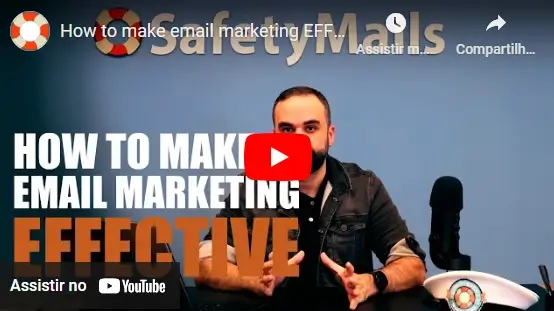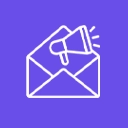It is undeniable that email marketing is one of the most effective digital marketing medias out there. Amongst them, email marketing stands out as the best return on investment (ROI).
However, along with its reputation for bringing good results, there are also countless questions marketers bring up: how to avoid being blocked? How to deliver more emails to inbox? How to get higher open rates? How to increase the number of conversions?
The answer to all these questions lies in adopting good practices for planning and executing email marketing in all its stages.
Sometimes, what happens is that sometimes email marketing is misconceived as sending emails with the objective of making sales. However, email marketing can be so much more. It is essential that email marketing is understood as a way to promote and strengthen relationships with the subscriber base and that it is a content marketing tool; that it aids in the content funnel and sales funnel, and that it allows you to deliver quality content for lead education. This is what makes email marketing much more effective.
Table of contents
How about watching this content on SafetyMails YouTube? Click now.

#1 – Have a plan
Stephen Kanitz once said, “It’s not the big plans that work; it’s the small details”. This means that if you don’t develop a plan, you end up ignoring important steps in the process of something you want to accomplish.
When we go on a car trip, for example, we think about the best route, the costs involved with fuel, tolls, food, and maintenance. We plan out the stops, accommodations, tourist spots we want to visit, and more. Skipping this planning step can affect your travel experience and cause you unnecessary headaches.
That is also true for email marketing. We need to plan our email marketing actions in all its aspects, since ignoring the details can lead to unexpected problems such as dreaded blocks, low open rates, and, of course, fewer conversions.
Establish a clear definition of the type of e-mail to be sent, dates and times to send them, the target audience for the action, objectives, and goals to be achieved, and which performance indicators will be monitored.
#2 – Establish objectives and goals for each action
I love this quote from Alice in Wonderland: “If you don’t know where you are going, any path will do”. In other words, how will you be able to say that an email marketing action was a success if you didn’t define the goal to be achieved?
So, before any email marketing action, define:
Action Objectives: Where do you want to go with your email? Re-engage inactive recipients? Get more hits for your website? Promote the sale of a specific product? Get people to join to Your Next Webinar? If you fail to define the action’s objective, you will make strategic mistakes in elaborating content and these mistakes will directly affect your results.
Action goals: Once you know where you want to go, you need to define what goal you want to achieve. For example, getting more hits for your website is important, but increasing the number of visitors by 12% is an achievable goal. Selling a product is important, but selling thirty units of that product is an achievable goal. Without goals, you won’t be able to measure whether or not the action was a success.
#3 – Take care of all technical aspects of email marketing
One of the most complex topics in email marketing is deliverability. This directly influences the behavior of email providers regarding the way messages will be handled on servers. These algorithms will define whether an email will be received or blocked and, secondly, whether it will be delivered to the inbox (behavior we call inbox placement) or the spam folder.
In short, these are some of the aspects that will build the reputation that your email marketing has with the various providers.
Authentications
Authentications are like passports to providers. They are responsible for ensuring that messages sent via email have their senders confirmed. In other words, this is what prevents a spammer from sending emails on behalf of a company or domain that does not belong to them.
Among the most popular authentications in the market, we can mention SPF, DKIM and DMARC.
In practice, you don’t need to know how to configure these authentications, but it is important that your email marketing platform makes these authentications functional.
This will ensure that you are not blocked by email providers from authentication failures.
Email volume
Email providers track the amount of messages sent by a sender on a daily basis. When this amount quickly increases, a blocking mechanism is triggered and you can no longer promote your campaigns.
To prevent this from happening, implement a practice known as warming up email lists. In practice, small volumes of emails are added little by little so that providers can follow the organic growth and thus understand their real behavior in email marketing.
Bounces / invalid email addresses
Pay special care to this aspect: email providers do not like invalid addresses, as well as email marketing tools.
In the email marketing market, we know that providers have a very low tolerance for invalid addresses. This tolerance, in most cases, is no more than three percent /93%). This means that it only takes a few invalid email addresses for your email marketing campaigns to be blocked and your opening/sales results and email marketing reputation severely impacted.
In addition to causing serious damage to your reputation, having invalid emails on your list means that countless business opportunities may be lost, as these people cannot be reached by email.
Another important aspect is that poor email lead generation also reduces your return on investment (ROI), as the same investment in lead generation will bring fewer valid emails, increasing the cost per lead (CPL) and, in the end, it will deliver fewer emails and your conversions will also be reduced.
Do the math: fewer emails generated at a higher cost and fewer sales will cause your return on investment to plummet.
Our recommendation, in this case, is that you take care of the quality of your mailings on the two most important business fronts: verify your existing email lists and check the quality of the capture of your registration forms.
For this purpose, email verification services such as SafetyMails suit your business perfectly. Through a simple upload, you can verify the validity of emails you already have and can also install the API in your forms to perform real-time email validation and prevent new invalid emails from being registered in your system.
Access the SafetyMails website now for more details.
Complaints
When you send unsolicited e-mails or even e-mails with inappropriate or unwanted content, the recipients may become annoyed and complain to the provider. The complaint is made by clicking on the “this is spam” button. That leads to severe blockages. Yahoo is a champion in blocking because of complaints.
Make no mistake: there are many reasons for a recipient to make a complaint. The frequency of emails sent, for example: if you send too many emails, you end up irritating the recipient with your insistence. If you barely send e-mails, the recipient may complain because they simply don’t remember who you are and they gave you permission to send the emails.
Code and content
This topic is exactly what you are thinking: everything in email marketing counts in order to enable better deliverability results.
When we talk about codes, we are necessarily talking about the content of the email:
With the proportion of images and text, make sure that your emails are not made entirely of images, as the antispam filters don’t like it very much (and the recipients don’t either).
About the words you use and even the way these words are written, be careful not to activate antispam mechanisms. And it’s not just the words that are in the body of the email, but also the ones that are in the subject line.
Also be careful with the hyperlinks you provide in your email. If any of those domains are listed on a blacklist, it may cause you problems.
Engagement
Here, one of the factors you need to focus on is to have it aplenty. The higher your email open rates, the greater the chances that more and more of your emails will be delivered inboxes in future campaigns.
The reason for this is simple: the higher your open rates, the more the providers’ algorithm will understand that the messages you send via email are relevant and, therefore, will tend to deliver your emails more.
Another important tip: seize the opportunity that transactional emails bring you. As this category of emails has high open rates, they will allow you to get better results in future campaigns. Take advantage of transactional emails and use them to promote your business, either with offers of related products and services or with suggestions for reading articles from your blog or for downloading materials. The important thing is that the recipient enjoys it.
That’s why segmentation is so important, as we’ll explain later.
#4 – Remember the 3 moments of email marketing
Before the email opening
Before opening a marketing email there are very important aspects that are essential for your campaign’s good performance and results.
Email messages compete for recipient time and audience. There are literally hundreds of messages received daily in a space that basically displays lines of text. Your reputation and creativity are paramount at this time.
Remember to strategically use the three main aspects that influence the opening of email messages:
- Sender: the sender plays an important role in convincing the recipient, especially if your brand is relevant. We often open an email simply because the sender is, say, Netflix or Amazon. People can also have this branding power. Let’s say you receive an email whose sender is Elon Musk or Bill Gates. Wouldn’t you pay attention to them? So, don’t overlook the importance of the sender and explore this feature as much as you can.
- Subject: Seven out of ten recipients will open an email because of the content of the subject line. It doesn’t take any other argument to justify the importance of this element for your email marketing results. So, be mindful of the length of the text; be direct in your communication, and use the mental triggers correctly, such as scarcity, urgency, opportunity, among many others.
- Preheader: This short line of text that appears after the subject line provides a brief summary of the content of an email. Since you can control what goes there, it’s worth thinking of the preheader as a second subject line, or an auxiliary subject line. Take this opportunity to get the recipient’s attention in order to get your message open.
During the email reading
The email has been opened. The first challenge has been completed. Now, the mission is to charm the recipient in order to keep their attention and lead them to a click action.
To achieve this goal, pay attention to the graphic elements and make sure they are properly distributed in the e-mail, with simple and direct text and an exciting call-to-action.
Pay attention to: images, types and weight, text, fonts used, reading distribution, distribution of elements, color scheme, and contrast.
Be especially careful with the email layout. Don’t put too much information or too many call-to-action options, as consumer behavior teaches us that people struggle when exposed to too many options. Be as simple and straightforward as possible.
After the email opening
Once the email has been received and opened, after the click, the recipient is directed to a URL. This address will be responsible for the recipient’s final conversion.
After all the effort you made to create attractive elements to ensure that emails are opened, content study, and design to lead to a click action, you won’t want to lose the recipient’s audience because of minor errors and oversights of the final homepages. Test everything to avoid mistakes.
There is a lot of content on the internet talking about building good landing pages that guarantee excellent conversion rates.
#5 – Make the correct construction and segmentation of your email list
Use digital baits and fulfilling experiences
You can capture new emails using online moments and offline moments as well.
In the online environment, you can get new subscribers offering that they subscribe to newsletters, opening test accounts on online platforms, downloading materials such as e-books or spreadsheets, accessing applications, or signing up for online seminars. Well, the possibilities are practically endless. Most importantly, your visitors need to see value in what you’re offering.
In the offline environment, forget about items like paper and pens. You must use digital devices even in these environments. Use QR Codes linked to registration forms, totems (be careful with this in these times when we must protect our health. Give preference to touchless registrations), scheduling apps, discount clubs, test-drive, and much more.
Email verify: make sure that the emails you capture for registration are good quality
Be sure to use all possible means to ensure that the registration of new subscribers is always a success. You invested a lot of time and resources to get the visitor to your landing page and you can’t waste that on a flawed process.
Therefore, all available help is welcome: use reviews to avoid common mistakes in typing email addresses, use the double confirmation technique (sending a confirmation email to the given address) and, of course, to add an extra special layer of quality and protection, install a real-time email verification service.
This service verifies the existence of an email account while filling out the form, in real time. This is important because often a typed email address has no errors, but refers to a non-existent account or even an email account that can cause damage to your email marketing, such as disposable email services or addresses with unwanted content. The real-time email verify service via the SafetyMails API ensures this extra layer of protection for your forms and your digital business.
Want to know more about this service? Access the SafetyMails website right now, create an account and get credits to try our services out for free.
Respect data protection laws
As you can imagine, people are increasingly concerned about how we use their personal data collected in registration forms.
Therefore, there is a worldwide movement towards regulating the possession and processing of personal data. In Europe there is the GDPR, in Brazil there is the LGPD and in almost all Latin American countries there are specific laws covering data protection. In the United States, although there is no general law for this purpose, there are numerous laws enacted at the federal and state level, such as the CCPA (California Consumer Privacy Act) and the NY SHIELD (New York Stop Hacks and Improve Electronic Data Security Act). And I could mention many other laws here.
The fact is, you have to be aware of these laws and ensure that your business complies with these laws. Develop documents that specify your data protection policies and apply these procedures in a professional manner, guiding your work teams, redoing registration forms, and restructuring the way this information is stored and handled.
And, of course, never share personal data without consent.
There is no “email sent to all”
Remember that email marketing is a direct marketing tool. That is, it assumes that you have a segmentable database, with information that allows messages to be correctly targeted.
Your recipients have different preferences and, for that reason, working with segmented lists will collaborate even more with your results.
First: a segmented list has fewer recipients. This means that the possibility of having higher opening rates will increase. This ensures better deliverability for your email marketing.
Second: a segmented list speaks directly to the real people interested in a particular subject or product. This significantly reduces the number of unsubscribes and complaints for sending spam.
Third: a targeted list lowers your costs. Sending fewer emails reduces the possibility of being blocked because of volume and also consumes less of your contracted plan on an email marketing platform.
Remember to use intelligent techniques to register new subscribers, asking the right questions on the registration forms, recording consumption behavior, among others.
#6 – Choose a suitable email marketing tool
It’s no use having the best preparation for your email marketing campaign to be a success, and then end up having problems because of the email marketing platform.
Be strategic when choosing a tool and don’t just use the free options. Also, don’t get carried away by highly complex tools if you really aren’t able to use all the possibilities it offers. That would be a waste of budget.
Conclusion
In order for you to carry out effective email marketing, you must be attentive and carefully take care of all the steps, with proper planning of the entire action, using techniques to overcome technical challenges, promoting a good experience for the recipient, and by constantly monitoring results to identify success factors or failed factors in your email marketing campaigns.



